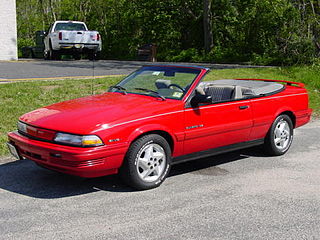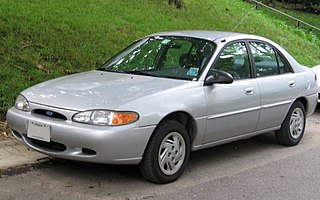
The Vauxhall Astra is a compact car/small family car (C-segment) that has been sold by Vauxhall since 1980. Over its eight generations, it has been made at several GM/Opel/Stellantis plants around Europe - however most versions have been sourced from Vauxhall's plant at Ellesmere Port, Cheshire, England.

The Honda Integra, sold in North America as the Acura Integra and later the Acura RSX, is an automobile produced by the Japanese company Honda from 1985 until 2006, and then since 2021. It succeeded the Quint as a more luxurious and sport-oriented derivative of the Civic. The Integra was one of the launch models for Acura in the US in 1986 alongside the Acura Legend. Throughout its production run, the Integra was highly regarded for its handling and performance. The 1995–2001 Integra Type R is widely regarded as one of the best front-wheel-drive cars of all time.

The Honda Civic is a series of automobiles manufactured by Honda since 1972. As of 2023, the Civic is positioned between the Honda Fit/City and Honda Accord in Honda's global passenger car line-up.

The Pontiac Sunbird is a model line that was manufactured and marketed by Pontiac from the 1976 to the 1994 model years. Loosely deriving its name from the Pontiac Firebird, the Sunbird was introduced as the eventual replacement for the Pontiac Astre, replacing it entirely in 1978 as the smallest Pontiac.

The Volkswagen Corrado is a compact four passenger (2+2), three door, front-engine, front-wheel-drive liftback coupe marketed by Volkswagen from 1988 until 1995, and manufactured by Karmann in Osnabrück, Germany.

The Renault Mégane, also spelled without the acute accent as Megane, especially in languages other than French, and also known as the Renault Megavan for an LCV in Ireland, as the Renault Scala in Iran and as the Renault Mégane Grandcoupé for the saloon in Israel, Palestinian Authority and Serbia for certain generations, is a small family car produced by the French car manufacturer Renault for the 1996 model year, and was the successor to the Renault 19. The Mégane has been offered in three- and five-door hatchback, saloon, coupé, convertible and estate bodystyles at various points in its lifetime, and having been through four generations is now in its fifth incarnation.
Geo was a brand of small cars marketed by General Motors (GM) as a subdivision of its Chevrolet division from 1989 to 1997.

The Chevrolet Cavalier is a line of compact cars produced by Chevrolet. Serving as the replacement of the Chevrolet Monza, the Cavalier was the second Chevrolet model line to adopt front-wheel drive. Three versions of the Cavalier have been sold, including three generations sold in North America from model years 1982 to 2005, a version produced by SAIC-GM for China from 2016 to 2021, and a SAIC-GM version produced for Mexico since the 2019 model year.

The Pontiac LeMans is a model name applied to automobiles marketed by Pontiac. The name came from the French city of Le Mans, the site of the 24 Hours of Le Mans, the world's oldest active sports car endurance race that began in 1923. Originally a trim upgrade package based on the Tempest, the LeMans became a separate model in 1963.

The Geo Prizm and Chevrolet Prizm were compact cars that were rebadged versions of the Toyota Sprinter, a vehicle that the Japanese automaker Toyota never directly sold in the North American market. The Sprinter itself was derived from the Toyota Corolla. The Prizm was marketed under the Geo nameplate until it was discontinued after the 1997 model year. After that, the vehicle was marketed under the Chevrolet nameplate. General Motors (GM) referred to this and other Toyota Corolla derived vehicles as the GM S platform. The cars were produced from 1988 to 2001 alongside the Corolla at NUMMI, an assembly plant operated as a joint venture of GM and Toyota. The Prizm was sold exclusively in the United States and succeeded the 1985–1988 Chevrolet Nova, which was also derived from the Sprinter and produced at NUMMI.

The Isuzu Piazza is a small, sporty 3-door liftback coupé which was manufactured by Isuzu from 1981 until 1992 in two generations. The Isuzu Piazza was marketed as the Isuzu Impulse in North America and as the Holden Piazza in Australia.

The Isuzu Gemini is a subcompact car produced by the Japanese automaker Isuzu from 1974 until 2000. The same basic product was built and/or sold under several other names, sometimes by other General Motors brands, in various markets around the world. While the first generation was of a rear-wheel drive design, later versions were all front-wheel-drive, and the last two generations were no more than badge-engineered Honda Domani until the name was retired in 2000.

The Toyota Sprinter is a compact car manufactured by Toyota as a variant of the Toyota Corolla. Exclusively sold in the Japanese domestic market, the Sprinter was aimed to be sportier than its Corolla sibling and also using different sheet metal mostly on the C-pillar. The Sprinter was sold exclusively at the Toyota Auto Store while the Corolla was sold at the eponymous Toyota Corolla Store, which focused on economical cars compared to the more upmarket Vista store.

The BMW 3 Series Compact is a car which was produced from 1994 through 2004 by BMW. It is a 3-door hatchback version of the BMW 3 Series through two generations, for the E36 platform in 1993 and E46 platform in 2001. Unlike most hatchback competitors which were transverse engine front-wheel drive, the 3 Series Compact uses the longitudinal engine rear-wheel drive layout.

The North American version of the Ford Escort is a range of cars that was sold by Ford from the 1981 to 2003 model years. The direct successor of the Ford Pinto, the Escort also largely overtook the role of the European-imported Ford Fiesta as the smallest vehicle in the Ford model line in North America. Produced across three generations, the first generation was a subcompact; the latter two generations were compact cars. Becoming highly successful in the marketplace, the Escort became the best-selling car in the United States after 1982, a position it would hold for much of the 1980s.

Sport compact is a United States marketing classification for a high-performance version of a compact or a subcompact car. There is no precise definition, and the description is applied to various models for promotional purposes.

Opel Performance Center (OPC) was a division of the German automobile manufacturer Opel, initially set up as a subsidiary in 1997. The main focus of OPC is the development of performance derivatives of the Opel range, such as the hot hatch Corsa OPC and Astra OPC.

The Corolla E90, introduced in 1987 for the 1988 model year, was the sixth generation of cars sold by Toyota under the Corolla nameplate. It was the last generation of Corolla to be classified as a subcompact car and the first to be exclusively front-wheel drive or all-wheel drive; the performance option of rear-wheel drive was dropped.

The Toyota Corolla E80 is a range of small automobiles manufactured and marketed by Toyota from 1983 to 1987 as the fifth generation of cars under the Corolla and Toyota Sprinter nameplates, with production totaling approximately 3.3 million, and most models adopting a front-wheel drive layout.

Passport International Automobiles (PIA) was a Canadian car dealership network owned by General Motors. It sold vehicles from Isuzu and Saab as well as its own branded Passport Optima, a Korean (Daewoo) made badge engineered Opel Kadett E, starting in model year 1988. General Motors' Geo import brand was introduced in the United States at about the same time. Sales began in mid-1987, originally only in major metropolitan areas. Only 83 I-Marks and Optimas were sold in 1987.























